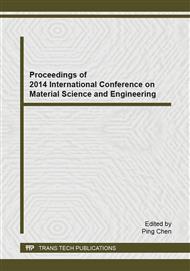[1]
R. Sahay, J. Sundaramurthy, P.S. Kumar, V. Thavasi, S.G. Mhaisalkar and S. Ramakrishna, J. Solid State Chem. 186 (2012) 261-267.
Google Scholar
[2]
S.S. Lee, H. Bai and Z. Liu, Water Res. 47 (2013) 4059-4073.
Google Scholar
[3]
C. Yang, X. Su, F. Xiao, Sensor Actuat. B-Chem. 158 (2011) 299-303.
Google Scholar
[4]
C. Liu, Y. Li, T. Minari, K. Takimiya and K. Tsukagoshi, Org. Electron 13 (2012) 1146-1151.
Google Scholar
[5]
T. Oku, R. Motoyoshi, K. Fujimoto, T. Akiyama, B. Jeyadevan and J. Cuya, J. Phys. Chem. Solids 72 (2011) 1206-1211.
DOI: 10.1016/j.jpcs.2011.06.014
Google Scholar
[6]
H. Zhang, M. Zhang, Mater. Chem. Phys. 108 (2008) 184-187.
Google Scholar
[7]
J.P. Li, F.Q. Sun, K.Y. Gu, T.X. Wu, W. Zhai, W.S. Li and S.F. Huang, Appl. Catal. A- Gen. 406 (2011) 51-58.
Google Scholar
[8]
A. Sadollahkhani, Z.H. Ibupoto, S. Elhag, O. Nur and M. Willander, Ceram. Int. 40 (2014) 11311-11317.
DOI: 10.1016/j.ceramint.2014.03.132
Google Scholar
[9]
W.X. Zhang, H. Wang, Y.M. Zhang, Z.H. Yang, Q. Wang, J.F. Xia, X.N. Yang, Electrochim. Acta 113 (2013) 63–68.
Google Scholar
[10]
T. Maruyama, Sol. Energy Mater. Sol. C. 56 (1998) 85-92.
Google Scholar
[11]
R. Nirmala, K.S. Jeon, B.H. Lim, R. Navamathavan and H.Y. Kim, Ceram. Int. 39 (2013) 9651-9658.
Google Scholar
[12]
M.A. Dar, Y.S. Kim, W.B. Kim, J.M. Sohn and H.S. Shin, Appl. Surf. Sci. 254 (2008) 7477-7481.
Google Scholar
[13]
J. Zeng, J.C. Xu, J. Alloy. Compd. 493 (2010) 39-41.
Google Scholar
[14]
D. Li, J.T. McCann and Y.N. Xia, J. Am. Ceram. Soc. 89 (2006) 1861-1869.
Google Scholar
[15]
Z.Y. Zhang, C.L. Shao, X.H. Li and L. Zhang, J. Phys. Chem. C 114 (2010) 7920-7925.
Google Scholar
[16]
S.S. Lee, H. Bai and Z. Liu, Water Res. 47 (2013) 4059-4073.
Google Scholar
[17]
B.J. Wang, L.Q. Luo, Y.P. Ding, D.H. Zhao and Q.L. Zhang, Colloid. Surface. B 97 (2012) 51-56.
Google Scholar
[18]
D. Li, J.T. McCann and Y.N. Xia, J. Am. Ceram. Soc. 89 (2006) 1861-1869.
Google Scholar
[19]
Q. Gao, J.K. Takizawa, M. Kimura, Polymer 54 (2013) 120-126.
Google Scholar
[20]
F.Z. Song, X.Q. Shen, M.Q. Liu and J. Xiang, Solid State Sci. 12 (2010) 1603-1607.
Google Scholar
[21]
L.L. Zou, M.X. Jing, J. Wang, P. Wang and X.Q. Shen, J. Nanosci. Nanotechnol. 14 (2014) 2446-2450.
Google Scholar


